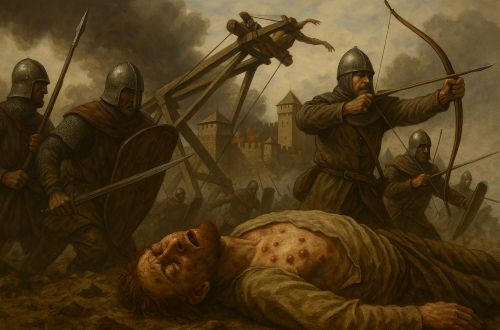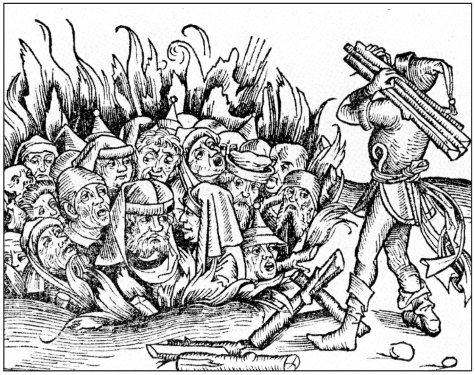

Attempts to weaponize plague in the medieval world reveal both tactical desperation and cultural anxiety. They demonstrate a desire to master nature’s most terrifying force.

By Matthew A. McIntosh
Public Historian
Brewminate
Introduction: Fear and the Shadow of Pestilence
Few terrors struck the medieval imagination with such force as plague. Its appearance was sudden, its spread incomprehensible, and its mortality overwhelming. The notion that such a horror could be directed, wielded intentionally as a weapon, gave rise to stories, rumors, and occasional efforts to make pestilence serve human ends. Warfare was never just about swords and siege engines; it was also about fear, and nothing inspired fear more powerfully than the specter of pestilence.
What follows is an inquiry into how plague was conceived, narrated, and at times deliberately applied as a weapon in the medieval world. It moves between theology and medicine, siege warfare and folklore, moral panic and strategic desperation. In doing so, it suggests that the plague-as-weapon belongs as much to the realm of cultural imagination as to the history of military practice.
The Medieval Understanding of Plague
Cosmological and Religious Interpretations

For medieval societies, plague was rarely understood as an impersonal disease. Chroniclers frequently described it as the lash of divine anger, a heavenly scourge sent to punish human sin.1 Astrological texts, meanwhile, identified planetary conjunctions as heralds of pestilence, interpreting disease as part of cosmic rhythm.
Within this framework, weaponization posed profound theological dilemmas. If plague was God’s tool, could mortals wield it without impiety? To many, the attempt would have appeared sacrilegious. Yet others reasoned that human malice might serve as an instrument of divine will, blurring the line between divine punishment and human agency. Accusations of weaponization thus carried moral as well as military weight, casting enemies as both profane and dangerous.
Early Medical Theories
Although theology dominated, medicine also provided explanatory frameworks. Galenic humoral theory described disease as imbalance within the body, while environmental models of miasma explained plague as vapors from rotting matter.2 In this sense, corpses were themselves agents of corruption, capable of poisoning the air around them.
At the same time, some writers hinted at contagion, noting how illness spread from person to person. Such observations, though undeveloped, made it plausible to imagine the deliberate spread of plague through contact. To those who believed in corrupted air, throwing bodies over walls seemed reasonable; to those who suspected contagion, forcing exposure seemed equally logical. Either way, theory encouraged the possibility of tactical use, even if practice remained fraught.
Historical Case Studies of Weaponization
The Siege of Caffa (1346)

The best-known episode comes from the Genoese port of Caffa. Gabriele de’ Mussi describes Mongol forces hurling plague-ridden corpses into the besieged city.3 Whether this was a calculated strategy or a grim disposal method remains debated, yet the story endured as an origin tale of the Black Death’s arrival in Europe. The veracity of this event remains debated among scholars.
The logistics would have been formidable. Siege engines could certainly catapult bodies, but the likelihood of spreading infection in this way is uncertain. Still, the symbolism was potent whether the story is true or not: the enemy was said to have made death itself into a projectile. Even if the act had limited biological effect, it succeeded as psychological warfare.
Localized Uses of Plague Victims
Beyond Caffa, chronicles mention bodies cast into wells or over city walls. These references may be exaggerated, but they reveal a cultural imagination ready to believe in plague as a weapon. Belief was not a stretch given stories such as that from Caffa. In some cases, even a single corpse was enough to terrify defenders, regardless of its true impact.
Rumor played as much of a role as reality. The fear of poisoned wells or tainted air could erode morale, spread panic, and weaken resistance. In this sense, plague’s imagined power often mattered more than its actual effectiveness.
Maritime and Caravan Routes
Merchants and caravans carried plague across continents, and accusations sometimes arose that infected goods were deliberately used to spread the disease. Cloth, in particular, was suspected of harboring contagion. Yet here the line between accident and intention blurred: plague traveled with commerce whether or not anyone intended it. Only in hindsight did contemporaries recast natural transmission as deliberate malice.
Cultural Imagination and the “Plague Weapon”
Folklore, Rumor, and Scapegoating

Weaponization also flourished in rumor. During plague years, Jewish communities were accused of poisoning wells, sparking massacres across Europe.4 These charges had little basis in reality, yet they transformed pestilence into a justification for persecution. Here plague became a social weapon, its imagined use more deadly than any physical deployment.
Chronicles and Moral Lessons
Chroniclers amplified such fears, portraying plague as an enemy’s instrument of divine vengeance. Narratives blurred event with moral parable: besiegers who unleashed disease were both cruel and impious, victims of their own hubris. Whether factual or exaggerated, these stories reinforced plague’s identity as a weapon, shaping how later generations remembered both war and disease.
Practical Challenges and Ethical Dimensions
Limits of Biological Control
The very nature of plague made it treacherous to weaponize. Transporting infected corpses endangered the handlers. Spread was unpredictable, often rebounding on those who sought to unleash it. Unlike fire or steel, pestilence could not be aimed, only loosed. Its most effective quality was fear itself, not reliability.
Ethical and Religious Dilemmas
Moral concerns deepened the uncertainty. If plague was heaven’s scourge, was its use an act of hubris? Some theologians condemned such tactics as blasphemy. Others, however, portrayed them as instruments of divine justice. To weaponize plague was thus to risk not only earthly retribution but also eternal damnation. The dilemma haunted medieval accounts, reflecting a fear that those who tried to wield death might themselves be consumed by it.
Legacies and Continuities
Influence on Later Ideas of Biological Warfare

Even if medieval uses were limited, their memory proved lasting. Early modern sieges occasionally echoed these tactics, and modern discussions of biological warfare often reach back to Caffa as a point of origin. The idea of plague as a weapon endured, shaping fears centuries beyond its medieval context.
Memory and Historiography
Modern historians wrestle with the problem of separating fact from legend. The Siege of Caffa has evidence (however debated), but much else is rumor or retrospective invention. Yet myth itself is historical: belief in plague’s weaponization influenced behavior and policy, even if the acts themselves were rare. In this sense, plague-as-weapon existed as much in narrative as in practice.
Conclusion: The Limits of Human Agency in the Face of Pestilence
Attempts to weaponize plague in the medieval world reveal both tactical desperation and cultural anxiety. They demonstrate a desire to master nature’s most terrifying force, even as its unpredictability thwarted control. Death itself seemed briefly within human grasp, yet it remained a weapon too dangerous to wield.
What emerges is less a story of successful military innovation than of imagination and fear. Plague-as-weapon belonged to the battlefield, the chronicle, and the rumor mill alike, reminding us that the boundary between history and myth is often porous. In the medieval world, pestilence resisted mastery, leaving behind not triumphs of strategy but cautionary tales of ambition against the unknowable.
Appendix
Footnotes
- Samuel K. Cohn, The Black Death Transformed: Disease and Culture in Early Renaissance Europe (London: Arnold, 2002), 11–15.
- Vivian Nutton, “The Reception of Fracastoro’s Theory of Contagion: The Seed That Fell among Thorns?” Osiris 6 (1990): 196–234.
- Mark Wheelis, “Biological Warfare at the 1346 Siege of Caffa,” Emerging Infectious Diseases 8, no. 9 (2002): 971–975.
- Robert Chazan, Reassessing Jewish Life in Medieval Europe (Cambridge: Cambridge University Press, 2010), 210–215.
Bibliography
- Chazan, Robert. Reassessing Jewish Life in Medieval Europe. Cambridge: Cambridge University Press, 2010.
- Cohn, Samuel K. The Black Death Transformed: Disease and Culture in Early Renaissance Europe. London: Arnold, 2002.
- Nutton, Vivian. “The Reception of Fracastoro’s Theory of Contagion: The Seed That Fell among Thorns?” Osiris 6 (1990): 196–234.
- Wheelis, Mark. “Biological Warfare at the 1346 Siege of Caffa.” Emerging Infectious Diseases 8, no. 9 (2002): 971–975.
Originally published by Brewminate, 09.10.2025, under the terms of a Creative Commons Attribution-NonCommercial-NoDerivatives 4.0 International license.


